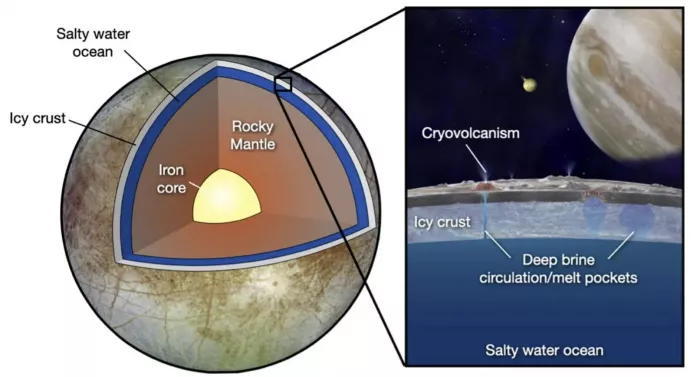Researchers at the University of Washington and the University of California at Berkeley conducted experiments to measure the physical limits of liquid water in the extraterrestrial ice and snow world This combination of Geology and engineering is designed to help find extraterrestrial life and robots explore the oceans on other planetary moons. The results were recently published in the journal Cell report physical science.
The results of this study show that cold, salty and high-pressure liquids found in the deep sea of other planetary satellites can remain liquid, and their temperature is much lower than that under lower pressure. This expands the range of possible habitats on icy satellites and will enable researchers to determine where to look for biometrics or signs of life.

The icy moons of Jupiter and Saturn, including Europa, Europa and Titan, are major candidates for extraterrestrial life in our solar system. These frozen satellites are thought to contain huge liquid oceans, dozens of times the size of the earth's Shanghai Ocean. Compared with these worlds, the earth is very dry.
The oceans on these satellites may contain various types of salt, which are expected to range from about 100 miles (160 kilometers) deep on Europa to more than 400 miles (640 kilometers) deep on Enceladus. We know that water supports life, but the main part of the ocean on these satellites may be below zero degrees Celsius, and the pressure is higher than anything experienced on earth. Researchers need to know how cold an ocean can be before it freezes completely, including in its deepest abyss.
The focus of this study is that eutectic, or salt water solution, can maintain the minimum temperature of the liquid until it is completely frozen. Salt and water are an example. Salt water remains liquid below the freezing point of pure water, which is one of the reasons why people sprinkle salt on the roads in winter to avoid ice formation. The experiment used equipment from the University of California, Berkeley, originally designed for organ cryopreservation and food storage for future medical applications. In this study, however, the authors used it to simulate conditions thought to exist on satellites of other planets.
The researchers tested solutions of five different salts at up to 3000 times atmospheric pressure, or 300 MPa, which is about three times the pressure of the earth's deepest trench. Knowing the minimum temperature at which salt water remains liquid under high pressure is indispensable to understand how extraterrestrial life exists and thrives in the deep sea of these ice ocean worlds.
NASA's Dragonfly mission will send a rotorcraft to Saturn's largest moon Titan in 2027. NASA is also leading the Europa clipper mission in 2024 to explore Europa, one of the many moons orbiting Jupiter. Meanwhile, the European Space Agency will send its juice spacecraft, the Jupiter ice and snow satellite probe, to explore Jupiter's three largest satellites, including Ganymede, Callisto and Europa, in 2023.